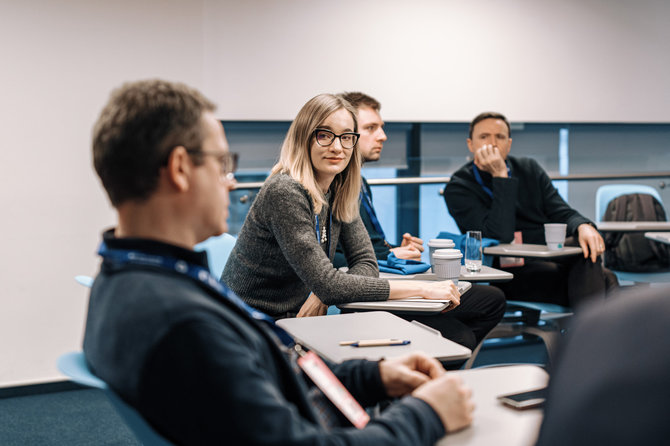A new design discipline will be added for older students, while subjects such as nutrition, textiles, construction materials and electronics will be based on design thinking principles across the board.
According to the Lithuanian Design Association (LDA), which advised the experts in preparing these changes, this will be one of the greatest breakthroughs in Lithuanian design education. A fresh approach to tech ed will equip secondary school students with the ability to identify problems, analyse issues, use their critical thinking, cooperate and have the confidence to experiment.
LDA design education expert Aistė Jakimavičiūtė-Bikauskė, who was involved in this curriculum revamp project, explains that the main change for tech ed teachers and students will be the use of design process methodology. Based on this model, specific achievement areas will be determined and four-level indicators for accomplishing these tasks will be identified. In other words, the goal will be not the technology itself or ways to master it, but the students’ ability to analyse contexts, challenges, materials or tools available. This approach will also teach children about planning their work, discussing their ideas and progress, prototyping and experimenting, testing and implementing changes in order to efficiently resolve problems.
“We know that competencies, rather than knowledge, are becoming a top priority of educational systems both in Lithuania and globally. This is why future education is being built not on imparting and acquiring knowledge but on strengthening the pupils’ ability to analyse this information, to assess it critically and be able to put it into practice as well as finding new, out-of-the-box solutions. Technology lessons are perfectly suited to achieve these goals. During these classes, students are given the tools and the materials but they need to learn not only to recognise and use them “as per instructions” but to adapt this knowledge effectively, solving both everyday challenges and unforeseen issues. I believe that the new elements of context, analysis, experimentation, environmental and market footprint, as well as discussion, will encourage creativity and entrepreneurship of our young people in the long term,” A. Jakimavičiūtė-Bikauskė says.
The revised general technology curriculum and its implementation recommendations are still in their draft phase, with the final version due to be adopted within the next few years. However, Jakimavičiūtė-Bikauskė believes that a consensus on the purpose, the goals and how the changes in tech ed will be implemented has already been achieved. The expert shares a simple example to illustrate the main change in approaching tech ed at school. Previously students would have been asked to assemble a bird house from wood during their design and technology class[MOU1] es. But the new programme will encourage students to analyse this bird house while they are building it, to discuss why it is needed and what it should look like. In addition, any existing solutions on the market will be analysed, the suitability and sustainability of raw materials will be assessed together with the tools needed for the job and the behaviours or specific “needs” of the birds the house is being built for. Students will also plan and discuss its construction project, any technological processes involved and mistakes made. They will be encouraged to discuss the successes and failures of their experimentation. Of course, the practical and functional aspects will also be taken into account – completing the bird house, with the motivation coming from understanding the context.
The success of these planned changes will depend on the teachers’ readiness to implement the updated general education curricula. With this in mind, the team of education experts together with the LDA developed the Technology teacher’s formal competence training as part of the ongoing project General education teacher’s general and formal competence training (project code 09.4.2-ESFA-V-715-02-0001), which will aim to help teachers with the implementation of new teaching programmes through the application of design process and STEAM teaching experiences.
The competence training programme includes three modules. The first module is dedicated to modern technologies and innovative teaching methods, while the second part provides a comprehensive introduction to the concepts of design and design process as well as opportunities for their application in the context of education. Teachers will also be introduced to the concepts of design and innovation, the challenges occurring in all areas of design, as well as ways to resolve them. The programme’s third module will cover technology teaching in the STEAM context and methods to improve practical skills in project planning, engineering solutions, problem-solving, organising work placements, implementation, assessment and other skills.
More focus on practical application
According to Eglė Vaivadienė from the National Education Agency’s Education Content Department Education Content Creation Section responsible for technical education in Lithuania, the updated programmes define technical education as an integral part of holistic STEAM (Science, Technology, Engineering, the Arts and Mathematics) education. STEAM develops the students’ technological literacy, their creative and critical, as well as lateral thinking, their ability to understand, make use of and evaluate the constant development of technologies in creative-production processes, forming a positive outlook on the transformation of technology in the past-present-future context.
In the context of technical education, STEAM is understood as the practical application of science, mathematics, economics, arts/design knowledge and engineering solutions, experimentation and modelling in a creative practical activity, performing technical processes needed to achieve the desired result. This education harnesses methods and principles of thinking based on the design process, which teach to recognise and conceptualise problems, create ideas aimed at solving problems, systemising, distilling, implementing, testing and presenting them.
“In the proposed project of the general education technology programme, the achievement areas were defined based on the classical design thinking model, which includes a multi-stage process of problem-solving: identifying the problem, focusing on the question at hand and studying it, generating ideas, choosing the best idea, prototyping, testing the solution and implementing it, followed by presenting the result and performing a (self)assessment. This model is suited to technology education because focusing on non-material design results (new skills, new insights and a reflective approach to technology) will enable students to become co-creators of our future society,” E. Vaivadienė explains.
Furthermore, through cooperation in tackling various tasks, students will enhance their digital citizenship as well as develop their critical thinking skills and learn about problem-solving as an integrated process. The knowledge gained during other lessons will be applied in various practical-creative activities.
Today, young people are part of an increasingly digitalised, globalised and ever-changing society so the competent employees and citizens of the future will have to be able to learn and apply new information both while working on their own and as part of a team.
“The ultimate goal of education, therefore, isn’t only the knowledge gained but understanding how it is acquired and where it could be applied. “Learning to study” and “being able to create new solutions” is becoming increasingly important. We believe that applying the design-based thinking model together with STEAM and entrepreneurship training in tech ed will help the 21st-century individual gain the necessary skills and competencies. Design thinking is widely used by many industries and academic communities to create solutions through repeat creative design and innovation processes. So starting to build these foundations at school is very important in order to develop a design-based approach to innovation and problem solving,” E. Vaivadienė comments.
The expert adds that based on teacher surveys, technology education could be improved by strengthening the teaching/learning base, tightening the link between tech ed and real-life experiences, encouraging cooperation among technology teachers as well as the scientific and business institutions. Other proposed measures include events for showcasing the achievements of tech ed students, various competitions for both students and teachers, a more open dialogue across all levels (school, municipal and national), diversity in teaching environments and closer coordination between formal and informal technology education.
Importance of tech ed
Algirdas Orantas, Chairman of the Board at LDA, says that the proposed changes are of particular importance to Lithuania’s competitiveness in that they will help to develop a modern, knowledge-driven, creative and brave society. According to A. Orantas, the value of design-based thinking manifests itself in many areas not directly linked to design through people’s ability to resolve various problems efficiently, systematically and creatively.
“The discipline of design has long outgrown the areas of aesthetics and visuals. Today contemporary design around the world encompasses and constructs processes, services and user experiences. Not every student has to become a designer, but understanding design and design-based product development will help young people gain the skills needed for braver and more unique solutions,” A. Orantas says.
The team of LDA experts advising on the proposed update of Lithuania’s technology education curriculum is comprised of Ieva Ščervianinaitė, Aistė Jakimavičiūtė-Bikauskė and Jonas Liugaila.













